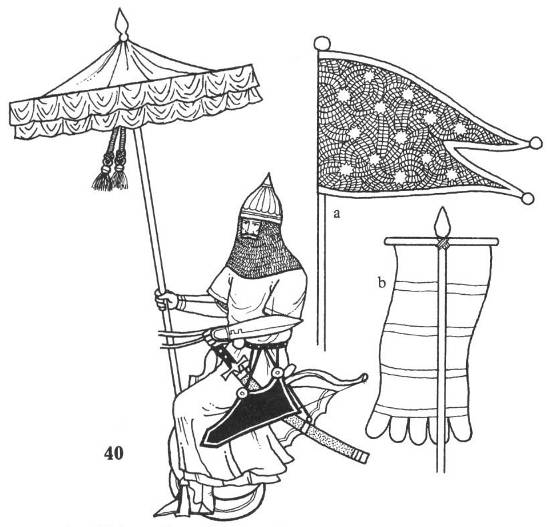
Shop Amazon - Create an Amazon Baby Registry
INDIAN PARASOL-BEARER
An extract from Armies of the Middle Ages, Volume 2by Ian Heath
[Based on a Timurid Zafarnama of 1436]



40. INDIAN PARASOL-BEARER
In this period as in earlier centuries Indian kings, and in the Hindu kingdoms noblemen too, were accompanied in peace and war by a parasol-bearing attendant, even in the midst of battle. The Hindus called the parasol a chatra, and amongst them the ownership of a white parasol was the exclusive privilege of a king. They were usually of silk or velvet decorated with pearls, precious stones and gold tassels, Domingos Paes describing the 2 parasols of state belonging to Krishna Devaraya of Vijayanagar as ‘all gilded and covered with crimson velvet’, adding that on hunting expeditions a blue parasol was carried. Barbosa tells us that ‘they are so made as to open and shut and many cost 300 or 400 cruzados’, which we know from elsewhere was the price of a cheap horse. In the sultanate of Delhi only the sultan himself was accompanied by a parasol, whereas amongst the Hindus every nobleman usually had his own. The figure depicted here is based on the same source as the last and carries a gold parasol.
Persian, Mongol and Timurid commanders were also accompanied by a parasol, at least for ceremonial processions, as too were Mamluk sultans. That of the last was called ‘the dome and the bird’, being of yellow silk embroidered in gold and surmounted by a gold-plated silver bird.
Although such parasols clearly served as a sort of standard, more conventional flags were also used in India. In the sultanate of Delhi the army’s flags were black on the right wing and red on the left, all apparently with gold stripes. The sultan’s own flag was also black, al-‘Umari telling us that ‘nobody can possess the black standard except him’. That of Qurb ud-Din (1316-20) was charged with a new moon, dragon or lion device, that of Mohammed ibn Tughluq (1325-51) a gold star at its centre, and that of Firuz Shah (1351-88) a dragon. The flags of the last were of such a size and weight that they had to be carried on elephants and could be seen from a considerable distance. The nobles too had flags, khans under Mohammed ibn Tughluq having 7 (or ‘almost 9’) and amirs ‘at least 3’, maliks therefore presumably having 5. The tug horse-tail standard described under 15 was also in use. Hindu army flags were similar to those of the Moslems, 40a depicting a star-embroidered Vijayanagar flag from a temple fresco of c. 1400 at Kanchi. The older style of elephant-standard described under figure 95 in Armies of the Macedonian and Punic Wars may also have survived until the very beginning of this period, 40b showing a green one from a 12th century painted box. The Hindus of Vijayanagar at least used horse-tail standards, both white and coloured.